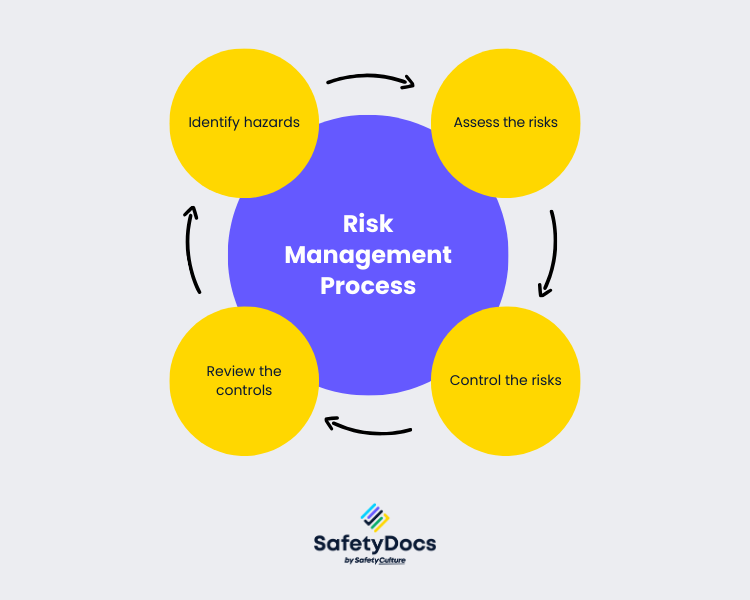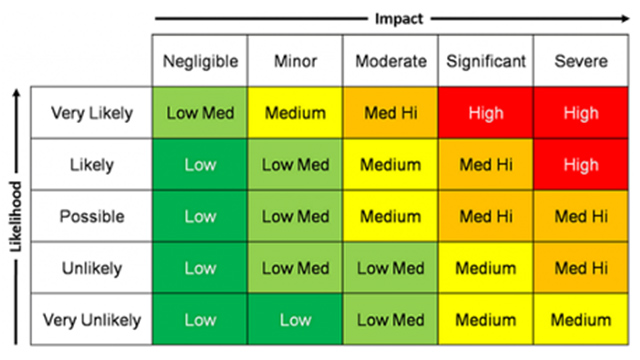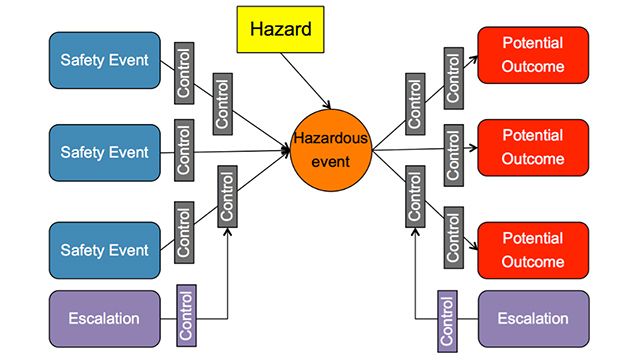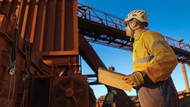One of the most important things you can do is conduct a risk assessment when it comes to workplace safety. These are fundamental in managing workplace health and safety. Imagine commencing electrical work without first identifying the presence of live wires. This can be dangerous to both the workers and anyone else who may be present in that area.
What is a Risk Assessment?
A risk assessment is a process or method for identifying risks and hazards in the workplace and assessing their potential impact on business operations. This process entails systematically identifying potential hazards, assessing their impacts, and implementing measures to control or eliminate them.
Purpose of Conducting a Risk Assessment
When it comes to safety in the workplace, one of the most important things you can do is conduct a risk assessment. You can use it to:
- Identify workplace hazards – risks can come from many sources, including chemical, physical, ergonomic, psychological, and social threats. It's essential to identify all potential sources of risk in your workplace to assess, prevent, and control them.
- Assess the potential impact of these risks – once you have identified them, you need to assess their potential impact or consequences. This will help you prioritise the risks, and develop a plan to address them.
- Develop control measures to reduce or eliminate the risks – after identifying and assessing them, you need to develop control measures to reduce or eliminate them. This may include changes to working procedures, employee training, or personal protective equipment.
- Monitor the risks and control measures – once you have implemented control measures, you need to observe them to ensure they are effective. This may involve regular audits or inspections of the workplace.

Understanding Hazard and Risk
Most people use 'hazard' and 'risk' interchangeably, but they are two distinct concepts.
What is a Hazard?
In workplace safety, a hazard is any source of potential harm or adverse health effect on someone or something. Hazards can manifest in various forms, like:
- Physical Hazards: Slippery floors, unguarded machinery, and loud noises.
- Chemical Hazards: Inhaling, touching, or ingesting chemicals like solvents and pesticides.
- Biological Hazards: Exposure to bacteria, viruses, and other pathogens that can cause illness or infection.
- Ergonomic Hazards: Strain caused by repetitive tasks, poorly designed workstations, or awkward postures.
- Psychosocial Hazards: Stressful work conditions, bullying or harassment in the workplace.
What is Risk?
Risk refers to the potential for loss or injury from exposure to a hazard. It involves assessing the likelihood of an event occurring and the severity of its consequences. Some factors that can influence risk include:
- The type and severity of the hazard
- The frequency and duration of exposure
- The number of people who could be affected
The different types of risk, are:
- Financial – the probability of a financial loss. For example, losing money in an investment.
- Physical – the probability of a bodily injury. For example, getting hurt in a car accident.
- Safety – the probability of an injury or death. For example, dying in a fire.
- Health – the probability of a health problem. For example, getting cancer from smoking cigarettes.
- Environmental – the probability of an environmental problem. For example, an oil spill.
All risks have the potential to cause harm. The degree of harm caused by a hazard is called the "severity." The likelihood of a risk happening is called the "probability." Some risks are more likely to occur than others. For example, the likelihood of dying in a car accident is much higher than in a fire. However, the severity of the harm caused by a car accident can be much lower than the severity of the damage caused by a fire. This is why it is crucial to consider the risk's probability and severity when assessing it.
Types of Risk Assessment
After identifying hazards and risks in the workplace, the next is to decide what type of risk assessment is necessary to address them.
Qualitative
This type of assessment uses descriptive analysis to evaluate risks, often relying on expert judgment. It's beneficial in workplaces where precise quantitative data isn't available. The assessment involves estimating each identified risk's likelihood and potential consequences and ranking them in order of priority.
Quantitative
This approach uses numerical data and statistical models to precisely calculate risk levels, which is ideal for data-rich environments. An instance of this kind of risk assessment is using a machine's data to predict when it will fail and the potential consequences.
Generic
These standardised assessments evaluate common risks associated with routine tasks across similar environments. In a retail chain, a generic risk assessment might address slip and trip hazards common in all store locations, providing a uniform approach to safety protocols that can be adapted as needed.
Site-Specific
These assessments are unique to a particular workplace and consider risks that may not be present in other environments. For example, an office building risk assessment might focus on ergonomic and fire safety hazards, whereas a manufacturing plant would also consider heavy machinery and chemical hazards.
Dynamic
This assessment involves continuous monitoring and evaluating risks in real time as work is carried out. It allows quick adjustments to control measures if new hazards or risks are identified during the task. This type of risk assessment is ideal for high-risk workplaces with constantly changing conditions, such as construction sites or emergency response situations.
Risk Management vs Risk Assessment
Before going to the when and how of assessing risks, companies must understand that risk assessment and risk management are not synonymous, risk assessment is part of the risk management process. Here are the differences in their processes:
Risk Assessment Process
The risk assessment process is a systematic approach that typically involves three key phases:
- Hazard Identification: This initial phase involves gathering information from various sources, including employee input, historical data, and workplace activity observations.
- Risk Analysis: In this phase, the identified hazards are analysed to understand their nature, including the likelihood of occurrence and potential consequences.
- Risk Evaluation: This step involves comparing the analysed risks against predefined criteria to prioritise them.
Risk Management Process
The risk management process encompasses a broader scope, integrating risk assessment into a comprehensive risk management strategy. It generally consists of four main steps:
- Identify hazards - Look for hazards in your workplace. Consider potential hazards to health, such as those posed by manual labour, the use of chemicals, and the sources of stress related to the work.
- Assess the risks - Evaluate the health risks posed by the identified hazards. Consider how likely someone will be harmed and how seriously they could be harmed if exposed to the hazard.
- Control the risks - Select the most effective control measures that are available and practical to eliminate or reduce the risks to health.
- Review the controls - Regularly update your risk assessment to ensure it is current.

When to Assess Risk
Risk assessments have proven effective in preventing accidents across various sectors. Here are some examples where it's proven to play a vital role:
- Ammonia Refrigeration Facilities: Risk assessments highlight critical ammonia storage and handling hazards.
- Construction Sites: Regular risk assessments identify hazards like falls, equipment issues, and harmful substances.
- Natural Disaster Preparedness: Risk assessments identify disaster risks like earthquakes, hurricanes, and floods for emergency planning.
These are only a few examples of situations where risk assessments are necessary. Generally, you should carry out a risk assessment if any of the following apply to you:
- Making preparations to launch a new product or service
- Changing your methods of completing tasks
- Relocating to a new location
- Making changes to your workplace
- Using new machines or equipment
- Altering the materials you use
Tools and Techniques
Conducting a risk assessment can be done in different ways. There are four tools or techniques for conducting a risk assessment.
Risk Matrix
A risk matrix is a simple way to display the probability and severity levels of risks visually. It's used during the assessment so you can see what level or likelihood of consequences there may be. The risk matrix has two axes: the horizontal axis is the probability or likelihood of an occurrence, and the vertical axis is the severity or consequence of a circumstance. The probability and severity levels are typically classified into low, medium, and high.

Once the risks have been identified and assessed, they can be plotted on the risk matrix. The risks are then prioritised based on their position in the matrix. The risks in the upper-right corner of the matrix (high probability and high severity) are the highest priority, and the risks in the lower-left corner (low likelihood and low severity) are the lowest priority.
Decision Tree
A decision tree is a graphical representation of the decision-making process. It's used to identify all the possible outcomes of a decision and the associated risks. The tree starts with a single node, representing the decision to be made. The branches of the tree represent the possible outcomes of the decision, and the leaves of the tree represent the risks associated with those outcomes.
The decision tree can be used to identify the risks associated with a decision and evaluate the possible outcomes. It can also be used to compare different options and to choose the option that is most likely to lead to the desired outcome.
Failure Modes and Effects Analysis (FMEA)
FMEA is a tool used to identify the potential failure modes of a product or process and assess the risks associated with those failure modes. FMEA is a systematic and structured approach to identifying the possible failure modes of development or operation and evaluating the risks associated with those failure modes.
FMEA is typically used during the design phase of a product or process, but it can also be used during the development, production, and service phases.
Bowtie Model

Image: Source
A bowtie model is a tool used to visually display the relationships between hazards, consequences, and controls. The bowtie model has three components:
- Hazards - the potential sources of harm.
- Consequences - the potential outcomes of the hazard.
- Controls - the measures that are in place to prevent or mitigate the impacts of the hazard.
The bowtie represents a clear distinction between proactive and reactive risk management. The power of this graphic is that it provides an overview of multiple possible scenarios, all within one diagram.
By conducting risk assessment, you can ensure your workplace is as safe as possible. Having the right tools for the job is essential, and with risk assessment software, you can properly and efficiently assess workplace risks. Ensure your workplace is safe by utilising the appropriate methods, documents, forms, or checklists.
Risk Assessment Software
Several risk assessment software is available to help you identify and assess the risks to your business. One such solution is SafetyCulture (iAuditor). It is a mobile-first application that lets you create, edit, and share safety audits and inspections. It helps you identify hazards, assess risks, and track corrective actions.
SafetyCulture is a global leader in workplace safety and quality assurance. The company's innovative software helps businesses worldwide deliver over 600M checks annually for compliance with regulations, industry standards, or best practices - all from one easy-to-use platform!
Features:
- Assign corrective actions
- Corrective and Preventive Actions (CAPA)
- Risk Assessment and Management
- Operational Risk Management
- Occupational Health Management
Is it Mandatory?
In Australia, risk assessments are generally mandatory under various work health and safety (WHS) legislation. In most cases, risk assessments are required by law and essential to running a safe and successful business.
PCBU Responsibility
Risk assessments are the responsibility of the person conducting a business or undertaking (PCBU). A PCBU is anyone who conducts a business or undertaking, including employers, self-employed individuals, and companies responsible for work premises.
Under the Work Health and Safety Act 2011, which applies in the Australian Capital Territory (ACT), New South Wales, Queensland, and the Northern Territory, a duty is imposed "to eliminate risks to health and safety, so far as is reasonably practicable, and if it is not reasonably practicable to eliminate risks to health and safety, to minimise those risks so far as is reasonably practicable."
Involvement of Employees
While PCBUs or employers are legally responsible for conducting risk assessments, workers must be part of the process. It should be done in a way that allows everyone who does that job or uses that equipment to:
- Share or give their input into the actual assessment
- Vote on whether they are happy with the findings
Strengthen your Risk Assessment with SafetyDocs
You must not let your guard down even for a second regarding the safety of the job. Conducting a risk assessment is key, and we know it can be time-consuming or sometimes difficult.
Although you may be uncertain about where or how to begin, you can enhance workplace protection by following the proper guidance to assess existing risks effectively. With SafetyDocs by SafetyCulture, you can always be ready for an audit and avoid potential penalties.
With our content-rich and customisable templates, you can save time, money, and resources by streamlining health and safety management. As a market leader in the online documentation for HSEQ (Health Safety Environment Quality), we offer Safe Work Method Statement (SWMS) templates, Safe Operating Procedures (SOPs) templates, Management System Content, Safety Management Plans, Checklists, Forms & Registers, all designed to meet your organisation's needs!
SafetyDocs can provide you with:
- Up-to-date safety templates to guide you with changes in the legislation for safety standards
- Guidance in conducting risk assessment using our Risk Assessment Form
- Industry-specific HSEQ documents for risk assessment
Choose from our collection of risk assessment forms for a variety of industries. Shop our products now or contact our friendly Customer Service team for assistance today.
Available for instant download and supplied in fully editable MS Word format for use in your business.
Please note that the above information is provided as a comment only and should not be relied on as professional, legal or financial advice.
Share This Article
